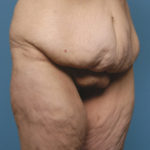
The reason fluid accumulates in this space under the skin is that wounded tissue weaps. Much like a brushburn that you had on your knee as a child, fluid comes leaking out from the wounded tissue. In the spaces left behind after big skin removals, a large surface area of wounded tissue lies underneath. This will weap fluid for weeks after surgery. Drains are inserted into these spaces to prevent fluid build-up. A soft tube is inserted under the skin through a small opening near the main incision. This drainage tube is then attached to a suction bulb which pulls fluid out by vacuum pressure. This is known as a closed suction drain. The drains are quite long, up to 18 inches in length. Usually one or more drains are used for surgical site depending on the procedure. (an arm lift needs one drain, a tummy tuck needs two drains, a body lift may need four drains) Some procedures such as breast surgery may not need a drain at all.
The removal of this fluid is of critical importance. While the body can absorb a certain amount of fluid, large amounts that occur after major body contouring surgery can not be absorbed. If allowed to build up, it may be a source of infection but will also not allow the sides of the wound inside to heal together. Therefore, the drains keep most of the fluid out so that adequate internal wound healing can occur. The drains serve as a safety valve until the internal weeping stops.
How long does this internal seeping persist?…or more pertinently, how long will you have to have these drains? It varies by the area and type of surgery. For arm lifts 2 to 3 days, thigh lifts one week, tummy tucks seven to ten days, and body lifts as long as two weeks. Some plastic surgeons use the amount of fluid coming out as the measure of how long they stay. Generally, less than 25 to 30 ccs per day per drain means they may be able to be removed.
Dr. Barry Eppley
Indianapolis, Indiana



